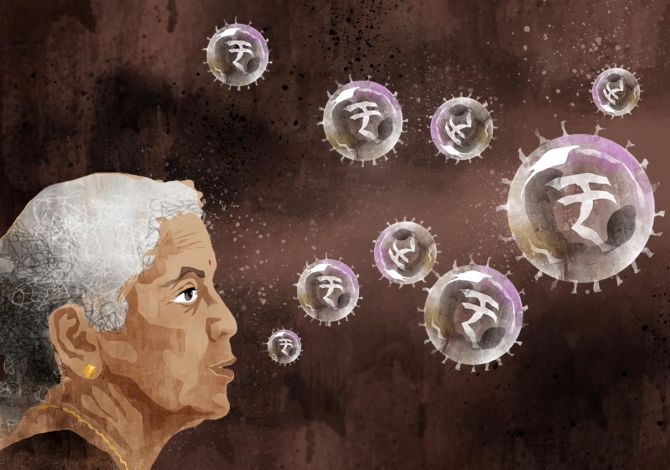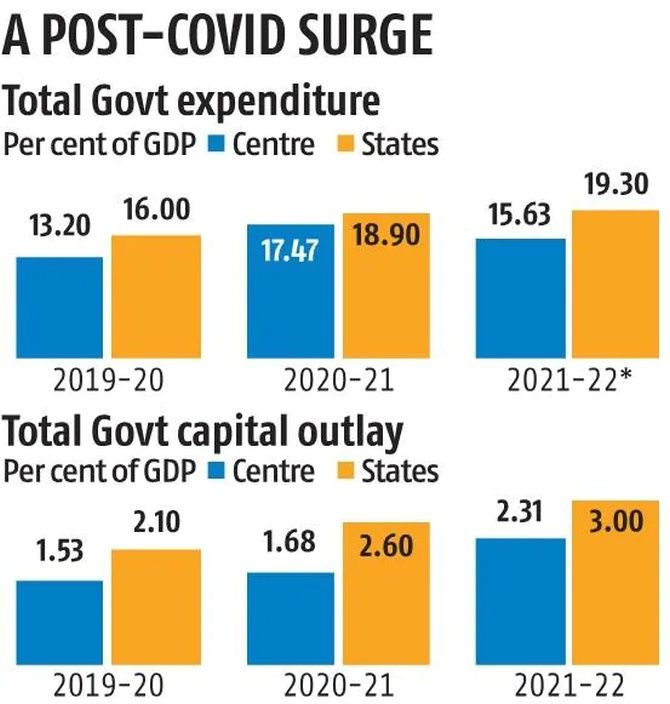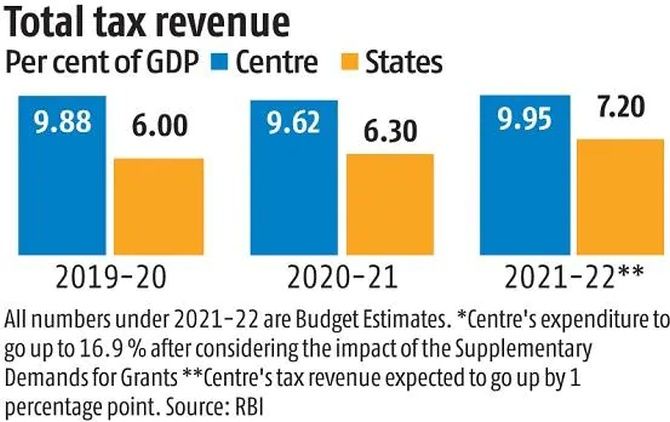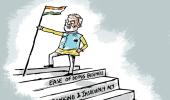If the Centre and states are keen on spending more to meet the COVID-19 challenges in the coming year, they must bear in mind the need to raise more resources through taxes and non-tax revenues, suggests A K Bhattacharya.

Governments respond to a crisis in different ways. If the crisis impacts the economy and requires the government to intervene with support measures, the response is often seen in the form of a substantial rise in government expenditure.
The global financial crisis of 2008 saw similar results even for India.
The combined government expenditure (including that of the Centre and the states) increased from about 29 per cent of gross domestic product or GDP in 2007-2008 to over 31 per cent in 2008-2009.
It stayed at over 31 per cent for two subsequent years, before settling down at around 29 per cent in 2011-2012 and even lower a few years later.
The combined government deficit also ballooned from about 4 per cent in 2007-08 to 8.4 per cent in 2008-2009 and over 9 per cent in 2009-2010, before taking a slow correction path to 7-8 per cent in the following two years.
COVID-19 surfaced on this planet about two years ago on the last day of this month.
Since then, it has continued to pose new challenges to the global health system and economic stability.
As expected, governments, including those in India, have responded to the pandemic through a variety of measures including an increase in expenditure.
But how has the expenditure boost played out for public finance in India in the last two years?
The first big takeaway for India's public finance is that, as it happened in the wake of past crises, governments after covid have become bigger.
Total government expenditure before the pandemic stayed at around 29 per cent of GDP. In 2020-2021, it went up sharply to over 36 per cent of GDP.
The seven percentage-point increase over the pre-pandemic trend rate is a big jump.
Remember that this was not because the Indian economy contracted by 3 per cent in nominal terms in 2020-2021, and the low denominator effect was at play.
The increase may have been accentuated by the contraction. But there was also an absolute increase of government expenditure in this period -- 28 per cent for the Centre and 12 per cent for the states.
A bigger government after the pandemic was only to be expected.
The surprise, however, was the difference in the quality of response from the Centre and the states.
The Centre was quick in responding to the challenge and it ramped up its expenditure from about 13 per cent of GDP in 2019-2020 to about 17.5 per cent in 2020-2021.
The states in 2019-2020 were already clocking a pre-pandemic expenditure rate of about 16 per cent of GDP and raised it to about 19 per cent in 2020-2021.

Clearly, the Centre responded with a far bigger stimulus in the first year of the pandemic than the states.
It is possible that the states' financial conditions did not allow them to come up with a better response.
Remember that the states in 2020-21 were complaining bitterly about not getting adequate compensation from the Centre under the goods and services tax regime and the extra borrowing they were allowed came in a little later during the year, constraining their expenditure plan.
The surprise is likely to be bigger in 2021-2022. In the normal course, government expenditure should have increased further or at least stayed at the same level in the current year.
Going by the Budget estimates, however, the combined government expenditure of the states and the Centre was to decline to about 35 per cent of GDP in 2021-2022.
Interestingly, the drive towards reining in government expenditure was to be spearheaded by the Centre.
The states raised their spending to over 19 per cent of GDP in 2021-2022, but the Centre promised remarkable fiscal restraint by cutting back on its expenditure by about two percentage points to 15.6 per cent of GDP.
But even before 2021-2022 has ended, the Centre's final expenditure levels are set to exceed substantially from those in the Budget estimates.
An additional Rs 3 trillion will be spent in the current year on subsidies and other schemes.
This would take the Centre's expenditure to 16.9 per cent of GDP, which would still be lower than the 2020-2021 figure.
The states may not exceed their expenditure estimates simply because they do not have the borrowing headroom to undertake such an effort.
Even after considering such additional expenditure, the size of government expenditure as per cent of GDP in 2021-2022 will be about 36 per cent, a little below 36.4 per cent in 2020-2021.

Two other features are noticeable in the way India's public finance has fared in the last two years after COVID-19.
One, overall capital outlay by both the Centre and the states has seen a healthy and steady rise.
This is a welcome development with capital outlay by the Centre and the states going up steadily from 3.6 per cent of GDP in the pre-pandemic year of 2019-2020 to 4.3 per cent in 2020-21 and to 5.3 per cent of GDP in 2021-2022.
Interestingly, the states have taken the lead in this area by accounting for more than half of what the Centre has spent in the post-pandemic years.
Two, tax revenues have seen healthy growth in the last two years.
Total tax revenues collected by the Centre and the states had seen a slowing down in the pre-pandemic years.
It fell from 17.8 per cent of GDP in 2017-2018 to 17.4 per cent in 2018-2019 and 15.8 per cent in 2019-2020.
The Centre and the states contributed to this decline in equal measure.
However, the post-pandemic year of 2020-2021 saw combined tax revenues go up to about 16 per cent of GDP.
In the current year, they were budgeted to be at 17.15 per cent of GDP. Given the current buoyancy, it is likely that tax revenues may even cross 18 per cent.
So, what do these public finance numbers tell us about what the Centre and the states should be doing in their Budget exercises for the next year? Governments getting bigger may be a necessity during a crisis, but this cannot be a sustainable strategy because of the obvious risks for growth and inflation management.
The combined government deficit in 2020-2021 was over 14 per cent and is expected to be brought down to 10.5 per cent in the current year.
If the Centre and the states are keen on spending more to meet the COVID-19 challenges in the coming year, they must bear in mind the need for steps to raise more resources through taxes as well as non-tax revenues, without which the fiscal deficit cannot be reduced.
In short, spending more, especially on capital outlay, is as important as fiscal consolidation through higher revenues by building on the gains made in 2021-22.
Shifting the burden of some central expenditure items to the states is not a good idea either.
Feature Presentation: Rajesh Alva/Rediff.com











